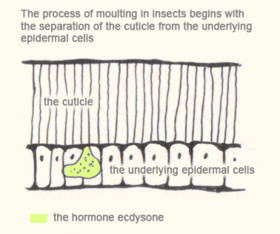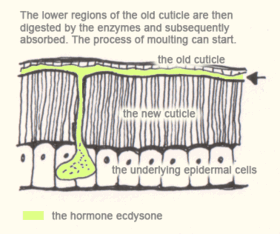Ecdysis

Ecdysis is the molting of the cuticula in arthropods and related groups (Ecdysozoa). Since the cuticula of these animals is also the skeletal support (the exoskeleton) of the body and is inelastic, it is shed during growth and a new, larger covering is formed. The old, empty exoskeleton is called an exuvia (or "exuvium").
After molting, an arthropod is described as teneral; it is "fresh", pale and soft-bodied. Within one or two hours, the cuticle hardens and darkens following a tanning process similar to that of the tanning of leather. It is during this short phase that the animal grows, since growth is otherwise constrained by the rigidity of the exoskeleton.
Ecdysis may also enable damaged tissue and missing limbs to be regenerated or substantially re-formed, although this may only be complete over a series of molts, the stump being a little larger with each molt until it is of normal, or near normal size again.
Contents |
Process

In preparation for ecdysis, the arthropod becomes inactive for a period of time, undergoing apolysis (separation of the old exoskeleton from the underlying epidermal cells). For most organisms, the resting period is a stage of preparation during which the secretion of fluid from the molting glands of the epidermal layer and the loosening of the underpart of the cuticle occur.

Once the old cuticle has separated from the epidermis, the digesting fluid is secreted into the space in between them. However, this fluid remains inactive until the upper part of the new cuticle has been formed.

While the old cuticle is being digested, the new layer is secreted. All cuticular structures are shed at ecdysis, including the inner parts of the exoskeleton, which includes terminal linings of the alimentary tract and of the tracheae if they are present.
Then, by crawling movements, the pharate animal pushes forward in the old integumentary shell, which splits down the back allowing the animal to emerge. Often, this initial crack is caused by an increase in blood pressure within the body (in combination with movement), forcing an expansion across its exoskeleton, leading to an eventual crack that allows for certain organisms such as spiders to extricate themselves.
Molting in insects

Each stage in the development of an insect between molts is called an instar, or stadium. Endopterygota tend to have few instars (4-5), while other insects such as Exopterygota can have anywhere up to 15. Endopterygota insects have more alternatives to molting, such as expansion of the cuticle and collapse of air sacs to allow growth of internal organs.
The process of molting in insects begins with the separation of the cuticle from the underlying epidermal cells (apolysis) and ends with the shedding of the old cuticle (ecdysis). In many of them it is initiated by an increase in the hormone ecdysone. This hormone causes:
- apolysis - the separation of the cuticle from the epidermis
- excretion of new cuticle beneath the old
- degradation of the old cuticle
After apolysis, molting fluid is secreted into the space between the old cuticle and the epidermis (the exuvial space), this contains inactive enzymes which are activated only after the new epicuticle is secreted. This prevents them from digesting the new procuticle as it is laid down. The lower regions of the old cuticle - the endocuticle and mesocuticle - are then digested by the enzymes and subsequently absorbed. The exocuticle and epicuticle resist digestion and are hence shed at ecdysis.
Gallery
External links
- John Ewer (2005-10-11). "How the Ecdysozoan Changed Its Coat". PLoS Biology 3 (10): e349. doi:. http://biology.plosjournals.org/perlserv/?request=get-document&doi=10.1371/journal.pbio.0030349.
- Scorpion (Centruroides gracilis) molting - several pictures.